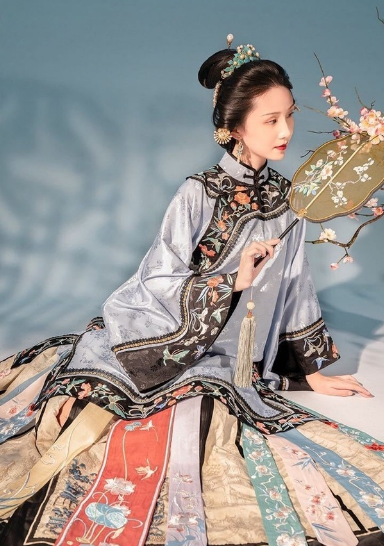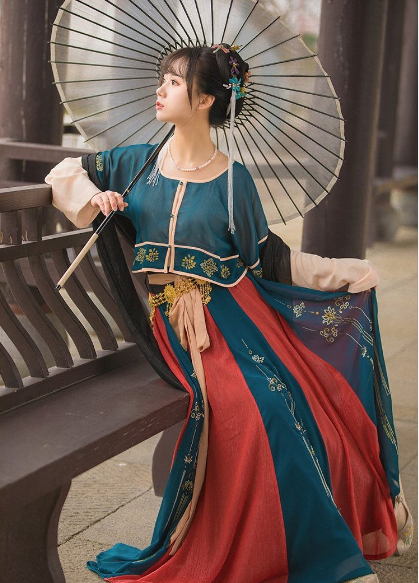In ancient Hanfu, certain colors like Imperial Yellow and designs like dragon motifs were exclusively reserved for the emperor and nobility,with strict regulations and severe consequences for violations.
Forbidden Colors in Ancient Hanfu
In the realm of ancient Chinese fashion, Hanfu stands out for its elegance and the deep cultural meanings embedded in its colors and designs. Strict color codes, a key aspect of this traditional attire, were not just about aesthetics but also about maintaining social order and hierarchy.
Specific Colors Reserved for Imperial Use
Yellow: The Emperor Exclusive Shade
Yellow, particularly the bright shade known as ‘Imperial Yellow’, was a color strictly reserved for the Emperor. This color, symbolizing the sun and the center of the universe, directly linked the Emperor to heavenly authority. Artisans created this distinct shade using rare and expensive dyes, making it exclusive to imperial garments. Any commoner or even nobility wearing this color could face severe repercussions, as it was an affront to the Emperor’s unique status.
Purple: A Mark of Nobility
The significance of purple in ancient Chinese society stemmed from its rarity and the cost of its production. Extracted from sea snails, this color was as valuable as gold, limiting its use to the garments of high-ranking officials and nobility. Purple, often seen in robes worn during significant rituals, symbolized wealth, power, and a deep spiritual connection with the cosmos.

Social and Cultural Implications of Restricted Colors
Upholding Confucian Ideals
The color restrictions in Hanfu clothing were a direct reflection of Confucian values. By assigning specific colors to different social classes, the ancient Chinese ensured a visible manifestation of the social hierarchy. This practice played a crucial role in maintaining order and harmony within society, as everyone recognized their place in the social structure through these color codes.
A Tool for Social Stability
The enforcement of these color codes was rigorous. Wearing a color above one’s social standing was not just a fashion faux pas but a challenge to the established order. Such transgressions often led to severe punishments, as they threatened the very fabric of societal stability. These strict rules regarding color and design in Hanfu thus served as a tool for social control, ensuring that everyone adhered to their prescribed role in society.
The forbidden colors in ancient Hanfu were more than just fashion statements. They were a critical component of the social, cultural, and political tapestry of ancient China. By regulating the use of specific colors, ancient Chinese society upheld its values and maintained a clear and visible social hierarchy.
Prohibited Designs and Patterns in Hanfu
The intricate tapestry of ancient Chinese society finds its reflection in the traditional Hanfu attire. Beyond colors, specific designs and patterns in Hanfu were exclusive to certain social classes, particularly the royal and noble classes. These restrictions played a crucial role in maintaining the social order and expressing cultural values.
Symbolic Motifs Limited to Royal and Noble Classes
Dragon Motifs: The Emperor Emblem
The dragon, a potent symbol of imperial power and divine authority, was a design exclusively used in the Emperor’s attire. Featuring five claws, these dragon motifs adorned the Emperor’s robes, representing his supreme command over all matters. Nobles and officials could wear dragon designs too, but with fewer claws, typically four or three, signifying their lower status compared to the Emperor.
Phoenix and Floral Patterns: Reserved for the Elite
The phoenix, often paired with the dragon, symbolized harmony and balance. It was a motif typically reserved for the Empress and high-ranking noblewomen. Floral patterns, such as lotus and peony, also held significant meanings. The lotus represented purity and enlightenment, while the peony stood for wealth and honor. These patterns were common in the garments of the elite, signifying their high social status.
Taboo Patterns and Their Historical Context
Birds and Beasts: Symbols of Authority
Certain birds and beasts, such as cranes and tigers, were also restricted in their usage. The crane symbolized longevity and wisdom, often featured in the garments of senior officials. The tiger, representing bravery and power, was a common motif in military uniforms but forbidden for the common populace.
Geometric Patterns: Indicators of Social Rank
Geometric patterns, such as circles and squares, also played a role in denoting social rank. Circles often symbolized heaven and infinity and were prevalent in royal attire, whereas squares, representing the Earth, were more common among the lower classes.
The intricate designs and patterns in ancient Hanfu were not mere decorations. They were a language of symbols, communicating social hierarchy and cultural values. This system ensured that everyone, from the Emperor to the common people, wore attire that reflected their social status, reinforcing the societal structure of ancient China.
Enforcement and Consequences of Violating Dress Codes
In ancient China, the strict enforcement of dress codes was a critical aspect of societal governance. Violating these sartorial rules, especially concerning forbidden colors and designs in Hanfu, resulted in severe consequences, underscoring the importance of clothing as a symbol of social order.
Historical Records of Dress Code Enforcement
Imperial Edicts and Local Governance
Imperial edicts often detailed the specific clothing regulations, which local authorities rigorously enforced. Officials conducted regular inspections, especially during important events and festivals, to ensure adherence to these dress codes. Historical records, such as those from the Tang and Ming dynasties, provide detailed accounts of these inspections, illustrating the seriousness with which authorities treated dress code violations.
Role of Community and Social Pressure
In addition to official enforcement, community surveillance played a significant role. Neighbors and fellow citizens often reported violations, as dress code adherence was a collective responsibility. This social pressure ensured conformity, making the enforcement of dress codes a community-driven effort.
Punishments for Wearing Forbidden Colors and Designs
Severity of Penalties
Penalties for violating dress codes varied in severity, depending on the social status of the violator and the nature of the transgression. Common punishments included fines, public humiliation, and in extreme cases, imprisonment or exile. For example, wearing the Emperor’s exclusive colors or dragon motifs could lead to severe punishments, including capital punishment in some cases.
Impact on Social Standing
Apart from legal penalties, violators often faced social ostracization. Wearing forbidden attire damaged one’s reputation, affecting not just the individual but their entire family. In a society where honor and social standing were paramount, this social stigma was a significant deterrent.
The enforcement of dress codes in ancient China was a complex system involving both official and community-level participation. Violations, whether intentional or accidental, had far-reaching consequences, affecting an individual’s legal standing and social reputation. These strict regulations and their enforcement underscored the deep-seated cultural significance of clothing in ancient Chinese society.

Exceptions and Loopholes in Hanfu Restrictions
While the rules governing the colors and patterns in Hanfu were stringent, there were notable exceptions and loopholes that allowed for some flexibility. These exceptions were often cleverly used by common people and evolved over various dynasties.
Instances of Common People Circumventing Rules
Creative Adaptations
Common people sometimes found ingenious ways to circumvent these strict dress codes. For instance, they would use similar but legally permissible shades of the forbidden colors or incorporate small elements of restricted designs into their clothing. This allowed them to express their fashion sense and aspirations subtly without directly violating the law.
Festivals and Special Occasions
During certain festivals or special occasions, the rules around dress codes were temporarily relaxed. This relaxation allowed commoners to wear more elaborate and colorful clothing than usually permitted, providing a temporary escape from the strict social hierarchy.
Changes in Restrictions During Different Dynasties
Tang Dynasty: A Time of Relative Freedom
The Tang Dynasty is known for its cultural openness and relative relaxation of dress codes. During this period, the strictness around colors and patterns eased, allowing for more vibrant and diverse fashion expressions among all social classes.
Ming and Qing Dynasties: Tightened Control
In contrast, the Ming and Qing dynasties saw a re-imposition of stricter dress codes. These periods marked a return to rigid enforcement, with even more detailed regulations dictating the specific clothing styles and colors for different social ranks.
Throughout Chinese history, the Hanfu dress codes experienced various phases of strictness and relaxation. While the rules were generally stringent, the common people often found creative ways to express themselves within these constraints. These exceptions and evolutions in dress codes reflect the dynamic nature of Chinese society and culture across different dynasties.







